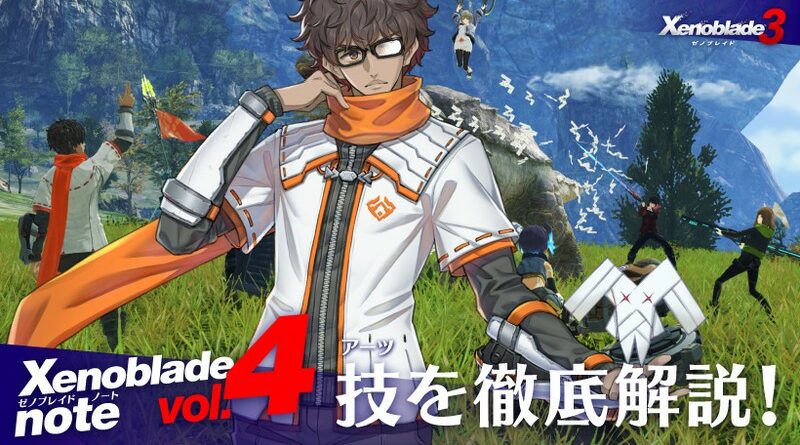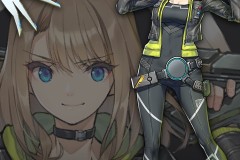Xenoblade Chronicles 3: Xenoblade Note Vol. 4 (Battle System: Arts and Fusion Arts, Classes and Class Change, Cancelling, Chain Attacks, more)
Nintendo have shared the 4th Xenoblade Note blog post on their Topics website, providing us with some more details about Xenoblade Chronicles 3. This time, the focus is on battles with a rather lengthy post offering an in-depth description of Arts and the battle system in general.
Here’s the list of blog posts available:
- Xenoblade Note Vol. 2 (Battle System)
- Xenoblade Note Vol. 3 (Exploring the world)
- Xenoblade Note Vol. 4 (Battle System: Arts and Fusion Arts, Classes and Class Change, Cancelling, Chain Attacks, more)
- Xenoblade Note Vol. 5 (Heroes, Cooking, Gem Crafting, new music tracks)
- Xenoblade Note Vol. 6 (Xenoblade Chronicles 3 Direct)
- Xenoblade Note Vol. 7 (Overview trailer, Battle System, Ouroboros, Heroes)
- Xenoblade Note Vol. 8 (Side activities, Expansion Pass, Commercials)
This new Xenoblade Note blog post features some video clips, featuring some more footage for the game. We went and gathered all video clips in a single video for your viewing convenience:
NB: not all video clips were new (some were previously shared via Twitter), but they’re now available at proper quality (1080p / 60fps)!
What are Arts?
Arts are techniques that characters can use in battle. They’re far more powerful than auto-attacks (that are performed automatically the moment battle starts). Arts are assigned to three of the face buttons (BXY to be precise), and all you need to do to use one is to press one of those buttons. However, once you’ve used an Art, it cannot be used for a little while: you need to wait for its gauge to refill (cooldown). Knowing when to use an Art is key.
Each character has its own strengths and weaknesses, which are also influenced by their Class. Each Class has its own set of Arts.
Noah’s class, Swordfighter
Swordfighters are Attackers who shine when attacking enemies from their flanks or their back. For example, the “Sword Strike” Art allows you to inflict the Break status to enemies when attacking from their flanks. As for “Edge Thrust”, it deals massive damage when attacking from the rear.
Mio’s class, Zephyr
Zephyrs are Defenders who use swift movements to dodge enemy attacks while attracting their attention (so that they don’t attack the other party members). The “Butterfly Blade” Art makes it so that enemies target you. It’s best used in combination with “Air Fang”, which increases attack power when enemies are targeting you.
Each class has 5 different Arts, but you can only set 3 of them to use in battle. Paying attention to the types of enemies you’re about to face and choosing the right Arts is critical.
Powerful Arts: Talent Arts
Each Class has its own Talent Art: a special Art that is far more powerful than regular Arts. In order to use it, you first need to fill up the Talent Art gauge, which is done by performing actions that match your battle role.
The conditions are as follows:
- Attacker: successfully attack enemies from the flanks or the rear
- Defender: successfully guard or evade enemy attacks
- Healer: successfully support the other party members by using recovery Arts or reviving them
By using your Arts effectively, and by performing actions that match your battle role, you can get to use some truly powerful techniques.
Swordighter’s Talent Art
Overclock Buster allows you to strike a powerful blow at the enemy, and it deals massive damage when said enemy happens to be stunned (Dazed status). Make sure to coordinate your attacks with the other party members who can inflict that status!
Zephyr’s Talent Art
Gemini Strike is a powerful technique that allows you to evade enemy attacks while attracting their attention. With this Talent Art, you can make it so that enemies target you while protecting the other party members at the same time.
The 6 Classes: Introduction
There’s 6 different classes in Xenoblade Chronicles 3:
Attackers
- Swordfighter: balanced, particularly effective against bosses and other powerful, unique monsters;
- Crusher: smash enemies with a heavy hammer. They’re power types who can deal heavy blows and can use Arts that break enemies’ guards. Unfortunately, their high attack power make them easy targets for enemies.
Defenders
- Zephyr: they use swift movements to taunt enemies, dodge their attacks, and unleash powerful counter-attacks with their Twin Ring weapon. They can also protect nearby teammates by making sure enemies don’t attack (and incapacitate) them;
- Heavy Guard: they attract the attention of enemies, and protect their allies with their large shield-like weapon. The many ways they can attract the attention of enemies make them powerful shields for the whole party.
Healers
- Medic Gunner: they can deploy healing circles with their Arts, healing and providing various buffs to characters who enter it. However, be careful: enemies will target you if you heal your allies too much;
- Tactician: they support their allies while perturbing enemies. For example, they can put enemies to sleep, but also make it easier for your party members to dodge enemy attacks.
Also, the Arts gauge fills up differently based on the class you’re using:
- Classes from Agnus (Swordfighter, Heavy Guard, Medic Gunner): fills up automatically over time
- Classes from Keves (Zephyr, Crusher, Tactician): fills up when auto-attacks land
More about Classes
Class change
In Xenoblade Chronicles 3, each Class has its own characteristics. And while each character has its own “starting” Class, you can switch to a different Class at pretty much any time. For example, you can switch from Swordfighter to Zephyr, turning an Attacker into a Defender.
Mastering Arts
While you can indeed change Class at pretty much any time, it’s better you don’t change too quickly/often. Indeed, if a character stays in a given Class long enough, they will master it: this allows them to keep using certain Arts even after changing to another Class. For example, if you change Noah’s class to Tactician, and then revert back to Swordfighter after a while, you will be able to use certain Arts that are normally only available to Tacticians.
Fusion Arts
If you fuse mastered Arts with the Arts of your current class, you can combine their two effects: this is called Fusion Arts. Those allow you to use two Arts at the same time.
And so, by using different classes for longer periods of time, you can increase the number of attacks your characters have access to, making them more versatile in the process.
4 ways to get the upper hand in battle
Switching Targets
If you’re fighting more than one enemy at a time, it’s recommended you switch targets and defeat them one by one.
Combos
If you cooperate with your allies and connect the right Arts, you can chain them into combos. When facing strong enemies, you start by breaking their defense (Break), before knocking them down (Topple), and then stunning them (Daze). More details about Combos will be shared at a later date.
Cancelling
When one of your attacks lands, you can immediately follow up with another Attack. If your timing is right, this will “cancel” the previous action, allowing you to chain attacks smoothly. If you’re successful, the character you’re controlling will be surrounded by a circle of light. Cancelling is pretty important as it makes it far easier for you to fill up the Chain Attack gauge, so make sure to Cancel attacks often!
Chain Attacks
There are various ways to fill up the Chain Attack guage:
- connecting combos
- perform actions that match your battle role
One the gauge is filled up, you can launch a Chain Attack: an extremely powerful move where all party members attack together.
Xenoblade Chronicles 3 (Switch) comes out on July 29th worldwide.
Source: Nintendo

















